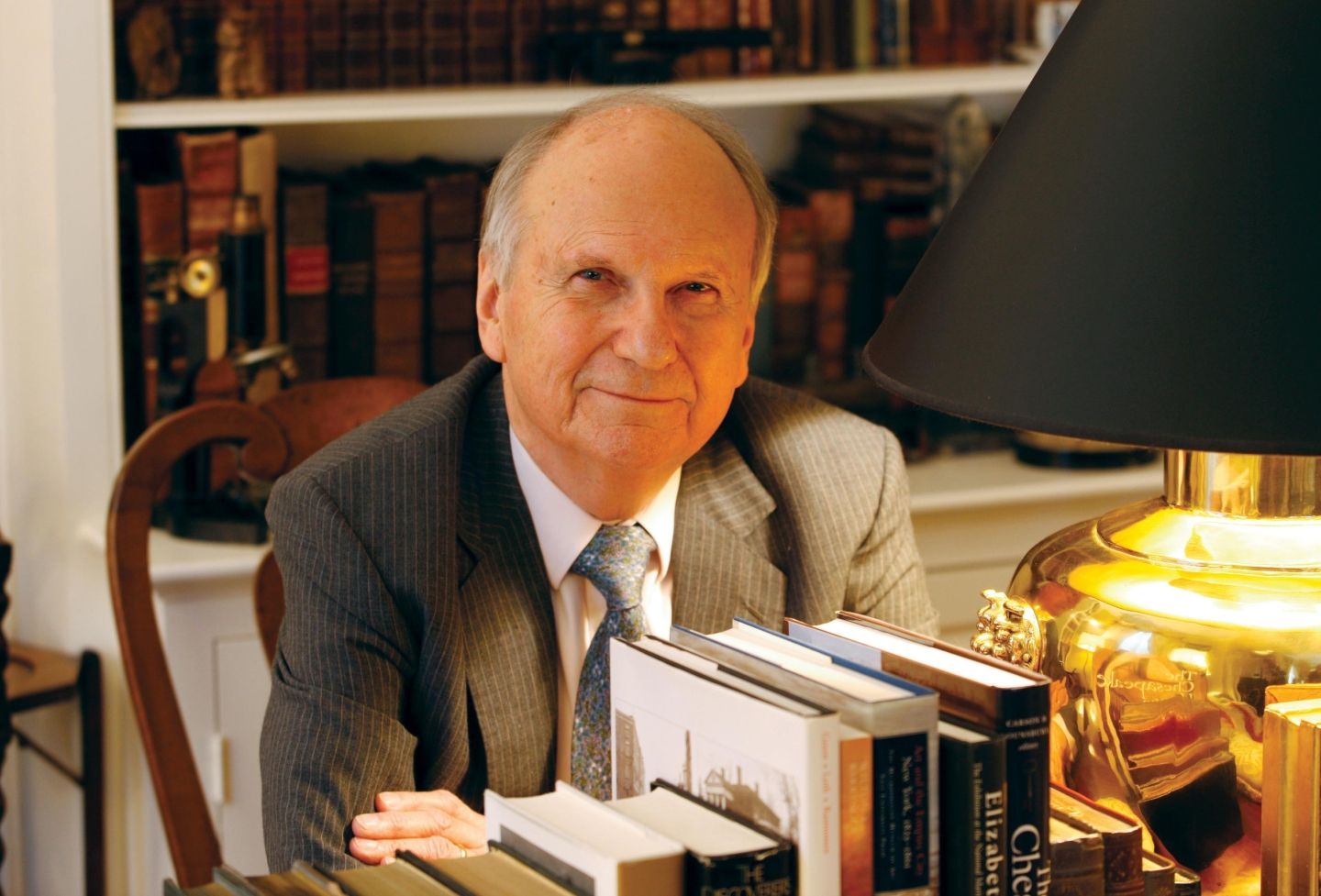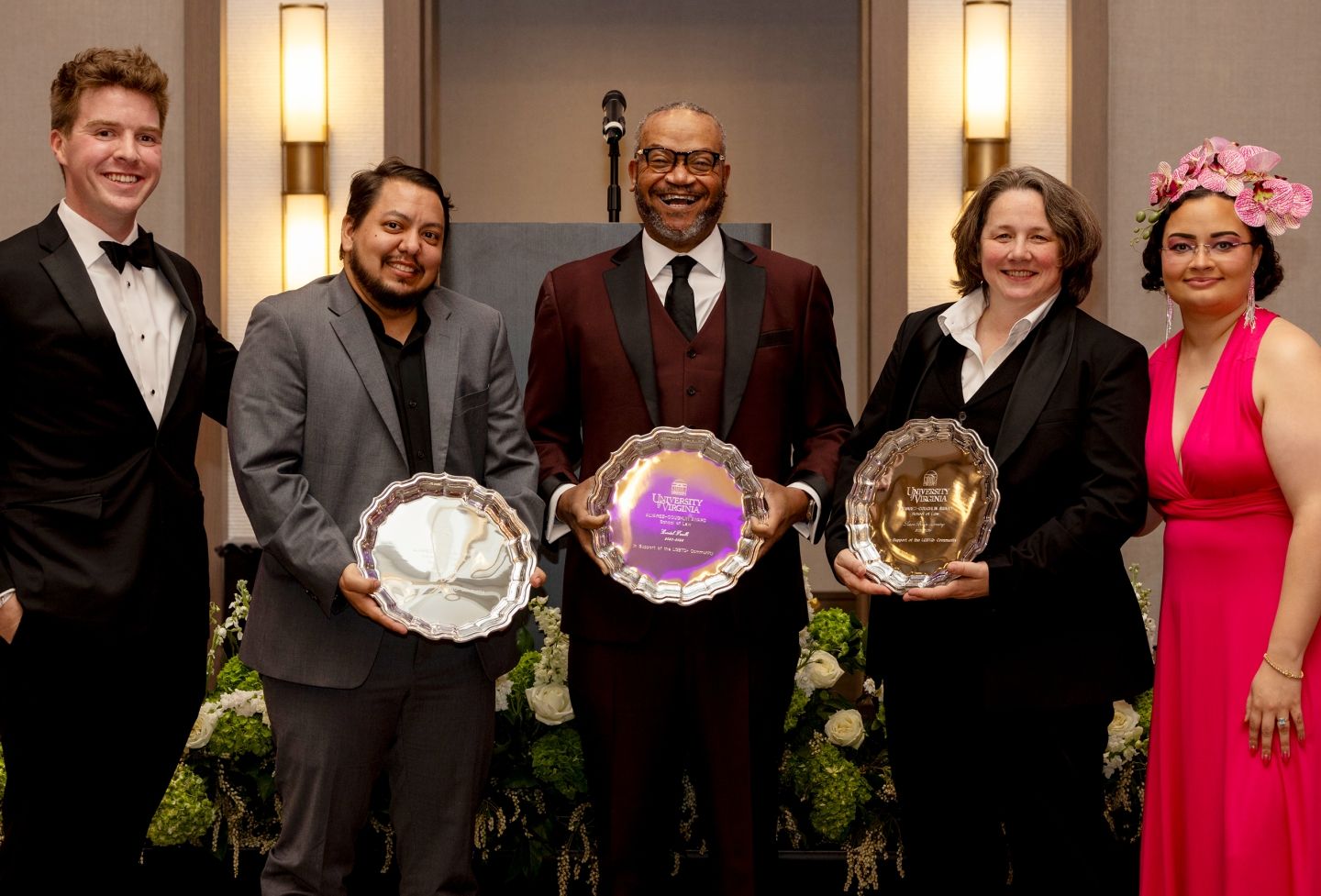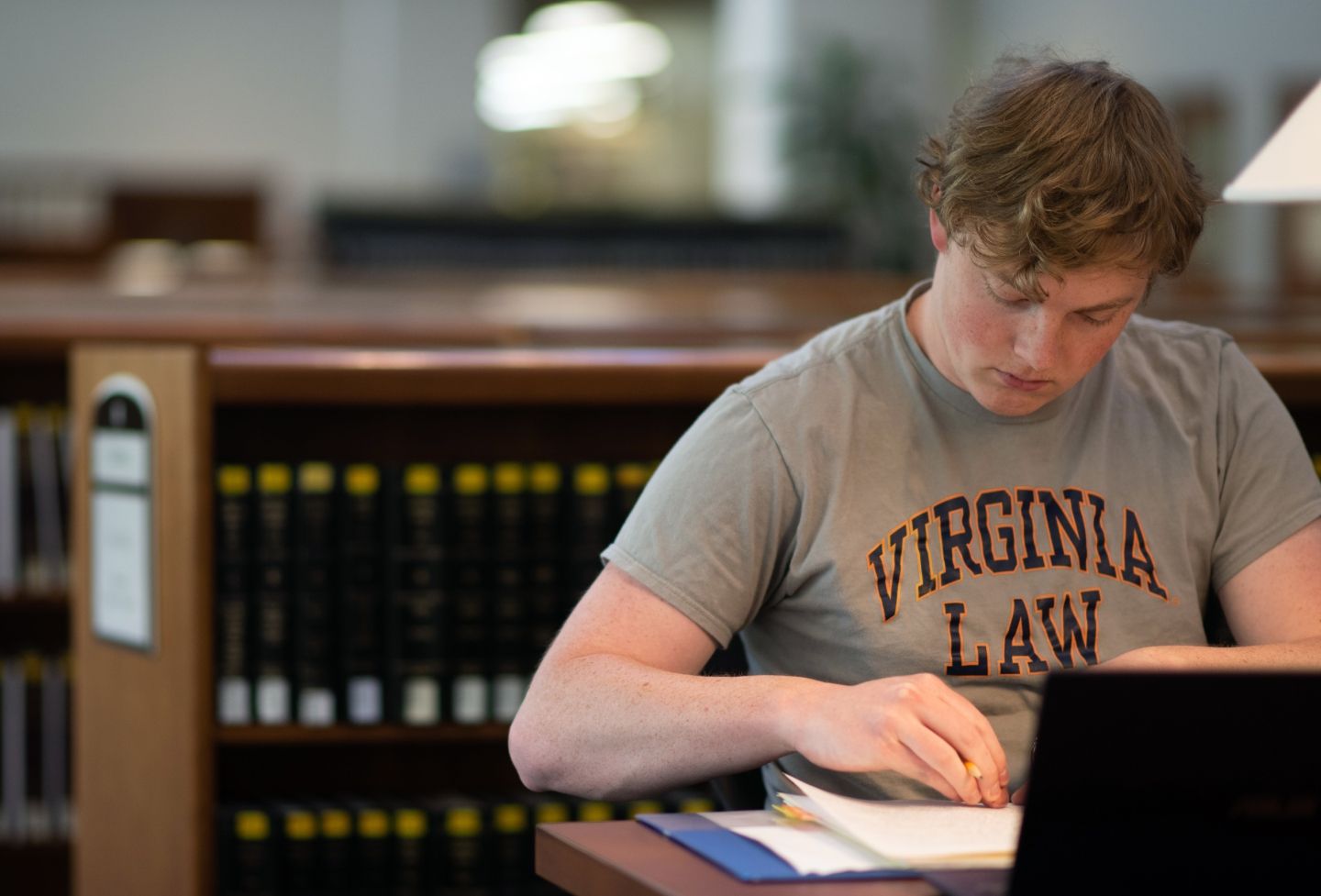Update: Plaintiffs in the Sines v. Kessler lawsuit, including lead plaintiff Elizabeth Sines ’19 claimed a significant victory in federal court in November 2021 against white supremacists who organized Unite the Right.
When Elizabeth Sines ’19 heard about a brewing march by white supremacists on the Lawn, then saw the men gathering as she drove nearby, she called her roommate, Leanne Chia ’19. Did she want to come? She did. The two University of Virginia School of Law students quickly found and followed the group of mostly white men on Friday as they marched up the Lawn toward the Rotunda, carrying tiki torches and chanting “Jews will not replace us” and “White lives matter.”
Soon the men would circle around the Rotunda to the statue of Thomas Jefferson, where a hastily assembled group of UVA students and community members surrounded the statue and held up a homemade sign that said, “VA Students Act Against White Supremacy.”
Then the rallying men attacked the counter-protesters, beat them with tiki torches and sprayed them with chemicals, until the police stepped in to disperse the crowd. Sines captured the video of the march and aftermath on Facebook Live, and the video went viral, collecting almost a million views. Chia and Sines have since told their story to The New York Times, MTV and Pantsuit Nation.
Throughout the weekend, Sines, Chia and several other Law School students, alumni, professors and staff stepped up to defend their community, their beliefs and the rule of law from a shocking series of events that many considered unthinkable — and some consider a reawakening — in Charlottesville. The town was the site of violence as white supremacists invaded from across the nation, organized in response to the proposed removal of the Robert E. Lee statue in Emancipation Park.
The Unite the Right rally was supposed to start downtown on Saturday at noon. But in town on Friday night, events kick-started early.
“There were not a lot of other people engaging, it was so intimidating,” Sines said of march they followed up the Lawn. But also, as she repeatedly told her Facebook audience while tracking the marchers, there were very few students around at all because school was not in session. In the end, the men “paid us no mind,” she said, as the students took on the roles of journalists, and the marchers laughed and waved at their phones.
On Saturday afternoon, Sines and Chia euphorically marched down Water Street with a massive group of counter-protesters who had, in effect, taken back Charlottesville. By then, police had deemed the main assembly of white supremacists in Emancipation Park unlawful just as it officially began, and dispersed the crowd. But counter-protesters continued to demonstrate, and in their moment of elation, a Dodge Challenger driven by James Alex Fields came barreling down on them. Local resident Heather Heyer, a counter-protester, was killed, and at least 19 others were injured. (Later in the day two policemen died in a helicopter accident.)
Chia and Sines missed being hit by just a couple feet. Sines later recalled Chia’s arm pulling her into a doorway, possibly saving her from injury as the car backed up. After the shock died down, and after helping other people on the scene in need, the pair retreated to the home of law student Josh Lefebvre ’19 to begin to understand what had happened. As they told their story, the pair seemed hopeful for the future. They wrote in The New York Times, “We witnessed domestic terrorism in our home. Neither of us regrets attending the rally, and we will keep showing up, every single time it’s necessary.”
We’ve collected stories of UVA Law community members doing just that. By Wednesday, we had talked to several, though not all, who participated in events this weekend. The text below offers a rough chronological timeline of what community members were doing this weekend. Two that we interviewed — lecturer Kim Rolla ’13 and Professor Barbara Armacost ’89 — served as National Lawyer Guild legal observers. The interviews have been edited and sometimes condensed for clarity.
FRIDAY
SINES: I was already on campus and I was driving around and I noticed that there were people carrying [unlit] torches.
ARMACOST: At about 9:30 I was walking home from an interfaith service at St. Paul’s Episcopal Church led by clergy preparing to counter-protest. I saw a group of men gathering on Nameless Field. As I watched from the parking lot in front of Memorial Gymnasium, the group got bigger and bigger and they began to light torches and march toward the lawn of my university. It was one of the most terrifying and horrible sights I have ever seen. I called 911.
CHIA: By the time we got up to the viewing platform, the students were already at the base of the statue. The torch-light holders had surrounded them completely. I think they knew that they were going to go to the statue.
ROLLA: As a National Lawyers Guild legal observer, I witnessed a group of close to 300 torch-wielding white supremacists — some with firearms visible — surround a few dozen students and community members, many of whom were people of color.
SINES: It was terrifying. They would form a circle around somebody, a counter-protester. They were hitting them with tiki torches, punching them, pushing them down to the ground. According to news reports, UVA Dean of Students Allen Groves ’90 was among the students around the statue and was hit by a torch.
ROLLA: Law enforcement in the area did not intervene, and as the white supremacist mob retreated, only one was arrested.
SINES: When violence broke out, that’s when it seemed like [the police] moved in, started grabbing people who were running out of the circle, and it looked like some kind of chemical was dispersed, pepper spray or something. It’s so challenging in those situations to see who’s doing what. Somehow they quelled whatever was happening.
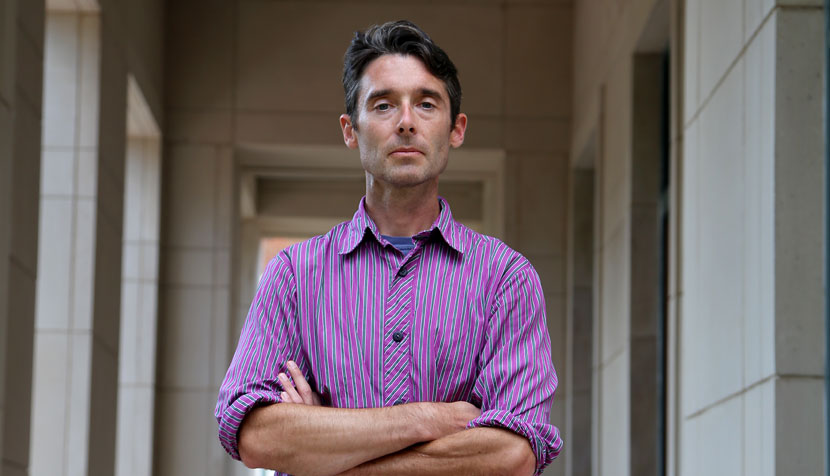 Ben Doherty, a lecturer and librarian at the Law School, marched with local activists.
Ben Doherty, a lecturer and librarian at the Law School, marched with local activists.
BEN DOHERTY, head of library instruction and research librarian: Doherty attended a service aimed at counter-protesters at St. Paul’s Church on Friday night, across from the Rotunda. There was fear they were going to march to the church after they went to the Rotunda. I couldn’t actually see them from the church. My heart goes out to the students. As a member of UVA, you want to be protective of the students. … The bravery of those UVA students was incredible.
SINES: [Protest organizer Richard Spencer] started coming up the stairs, maybe a minute into everyone fighting. … It was a group of young white men. … We realized it was his security with him. They acted like we were threats. I couldn’t help it, it just flew out of my mouth, “You’re scared of us?” Spencer tried to yell out a statement about winning the streets, but his megaphone had run out of battery power. He just turned to suddenly leave. I thought at the time he was trying to run away from police. … Leanne and I followed him to film.
SATURDAY
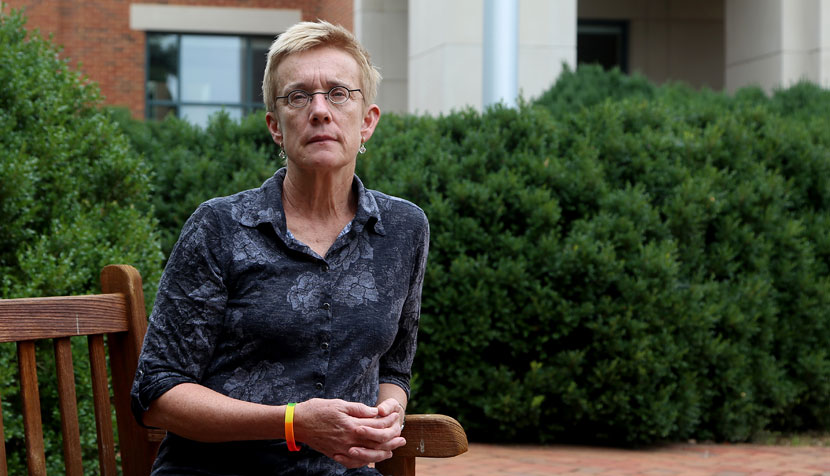 Professor Anne Coughlin and her husband, Mark, drove street medics on Saturday.
Professor Anne Coughlin and her husband, Mark, drove street medics on Saturday.
ANNE COUGHLIN, professor: We originally thought we would be legal observers. We then did a fair amount of thinking about where we would be most helpful and we got involved with a group of anti-racist activists who were working to support Black Lives Matter in Charlottesville. Through a variety of conversations with those folks, we’d decided to provide off-site support. And then the irony of course was that the off-site support became very much on-site in a real sense. We volunteered to drive a van for the street medics working from the First United Methodist Church, which is across the street from Emancipation Park. From their experience at the KKK rally on July 8, they knew there was potential for a whole range of injuries both physical and psychological.
We helped the medics in a variety of ways, but our main role was to drive their van whenever they needed it, where they needed to go in and out of the fray. We took people to the emergency room, we helped pull people out of the crowd who had been tear-gassed or pepper-sprayed and needed to come back to the street medic site just to be hosed down.
DOHERTY: After a sunrise service at First Baptist Church, I accompanied local activist groups to serve as a buffer and provide emotional support as they marched through Downtown. A busload of Nazis showed up in the Staples parking lot, and we were pretty scared, but these four community members just happened to be walking by at the same time, and they stood in between us and the Nazis, which I thought was just such an amazing gesture because these Nazis were scary. [The Nazis] were all lined up with shields and helmets and sticks, and they just stood between us.
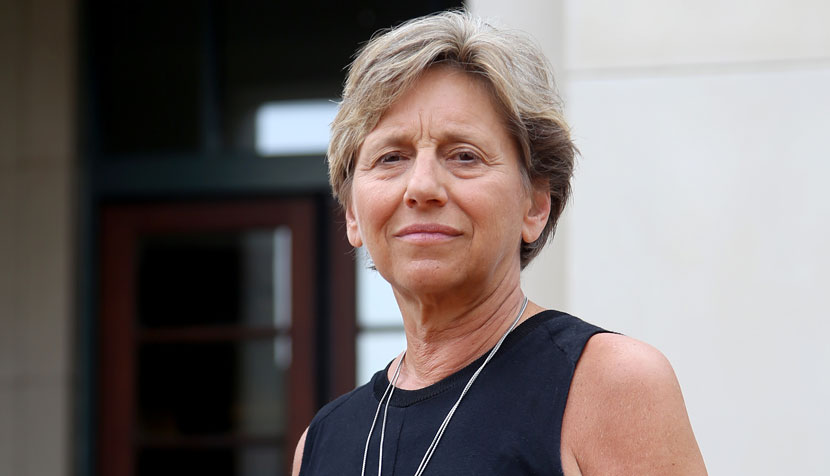 Professor Barbara Armacost served as a legal observer for the National Lawyers Guild.
Professor Barbara Armacost served as a legal observer for the National Lawyers Guild.
ARMACOST: Armacost, who has a master’s degree in theology, had started her day downtown with a group of clergy and faith leaders before she began her role as a legal observer at 10 a.m. I felt torn about how to participate on Saturday. As a person of faith, I believe the church must exercise a prophetic voice against injustice. People of faith have a moral responsibility to speak against injustice and oppression and to speak for marginalized people. This is about pursuing God’s purposes in the world. I wanted to be part of that prophetic voice.
But I am also a lawyer. I decided that the best use of my time and talents was to serve as a legal observer at the rally. Being a legal observer was a new role for me. Legal observers wear identifying clothing (in this case green hats) and our role was to observe and document in writing events as they unfolded, with special attention to police action and interactions with counter-protesters. I was working with a team of about twenty five legal observers from Charlottesville, Richmond and DC. (One came all the way from Seattle!) Legal observing put us right on the front-line of the unrest around the park, on Market Street and on the mall. I had the privilege of working with two of our law students (one very closely). I knew they had my back. It made me very proud. We all saw awful things that day, including one observer who saw the car plow into counter-protesters. It was a very hard day.
KEVIN COPE, research assistant professor: Toward the beginning of the day I was surprised at how civil people were. But that didn’t last long.
MILA VERSTEEG, professor: We had planned to stay home. But then, as CNN showed swastika flags being marched on our street, we decided to go out after all. It was horrible. All this hatred in young men, who are among the most privileged on this planet.
ARMACOST: There were all these screaming white supremacists in the park with all their flags, and they were shouting terrible things and wandering in and out. They were aiming threats at the counter-protesters, who were aiming threats back. It was just kind of bedlam on the streets. Lots of people had guns and shields and other weapons. There were multiple skirmishes between opposing groups and lots of street brawls where people got badly hurt. I kept wondering why no one in law enforcement seemed to be intervening to break up the fights. That was horrifying to watch. In between it would calm down, but not for long. In retrospect I am amazed that no one started shooting. I am glad I didn’t think about that at the time. I would have been terrified. But I was busy trying to do a job.
CHIA: We got there at 11:30. When we were driving I got these texts from friends [including Courtney Koelbel ’19] who were legal observers and they were already like “Don’t come, there’s already fighting, it’s chaos.”
ROLLA: One of the most consistent themes was the almost complete absence of law enforcement intervention during intense violence, both on Friday evening and Saturday at Emancipation Park. Law enforcement did, however, intervene with force and chemical agents against counter-protesters later in the day on the Downtown Mall.
COUGHLIN: This may sound weird but it was good that we had something very specific to do. It helped me get through what otherwise was unbelievably terrifying. Almost right in front of me, a man pulled a handgun and pointed it at somebody who had thrown paper at him. I think it was paper, or something like that. In the moment, I had no mental space to process what I was seeing because we had a job to do. We had to keep going.
ARMACOST: The white supremacists were frightening. The most horrifying thing was the level of their anger and aggressiveness. Some of them spit on the clergy. They threw insults and shouted racist and anti-Semitic epithets. After the unrest had been going on for at least two hours — and before the permit to use the park had even officially started — the police declared the gathering in the park an “unlawful assembly.” Things were clearly escalating and threatening to get completely out of control. The riot police moved in and used an advancing line of officers with helmets and shields to clear the white supremacists out of the park. One of the most moving things I saw on Saturday was the few moments right after the white supremacists were moved out. The counter-protesters surged in and for just a few minutes they held the park. There were shouts of a kind of surprised joy. There was a sense of “Oh my gosh, we just took over the park and drove them out.” And it was just a moment, of course, because the police cleared them out then too. But it was a wonderful moment.
COPE: I think there was a sense that things were dissipating, that people were starting to disperse, but only starting, right? But that’s actually when things I think became more dangerous. I think people felt like they had more anonymity because they weren’t being monitored by a phalanx of police in riot gear. People felt freer to act on their impulses.
SINES: We left [the scene at Emancipation Park], and people kept saying if you are a counter-protester, go to McGuffey Park. [We went there.] The only way to describe it is, it was like a resistance camp at the end of the world. It was only counter-protesters, and everyone was just relaxing.
SINES: They asked us to mobilize [after hearing a report of attacks on people of color in another part of the city]. … We were about 300 people at this point. We just began walking, and it was unreal how beautiful the feeling was. We felt so strong and unified. The diversity of the group was tremendous. … It really did feel like we had won. There was no white activist group in sight, it felt like we had really accomplished something. We had chased these people out of town, if you will. We felt so safe.
DOHERTY: Doherty marched with his wife, UVA English Professor Lisa Woolfork, and others in his group. The march was proceeding down Water Street and turning on to 4th Street to head to the Mall when the car plowed through. We were about a hundred feet behind where the car hit.
SINES: Obviously, it happened really quickly and it’s all kind a blur. We saw the crowd parting in front of us. I don’t know exactly how we made it over to the side of the road, but we jumped to the right side of the road. I remember someone getting hit in front of me, and me jumping over them. There was a doorway there and Leanne pulled me down into the doorway of a business. As soon as it happened, I thought this was an accident. Whoever was driving this car didn’t mean to, you know, press on the gas instead of pressing on the brake. But when he started to back up and hit more people … then it became obvious that he was trying to kill as many people as he could. That’s when the panic really set in for me. Someone yelled “Go to the alleys, go to the alleys.” They went into an alley, then climbed stairs. They were still live on their phones. I immediately started getting phone calls from my family and my friends. When more people came up who were traumatized by having friends hit, they shifted their attention. I think in that moment something just kind of clicks for you, where you just stop crying, like adrenaline or the will to help other people just kind of kicks in.
CHIA: We just comforted her.
Sines and Chia described a chaotic scene afterwards as tear gas was dispersed and medics treated the wounded and those in shock. The signs that people had carried in protest were now used to shield those being treated.
CHIA: I really thought it was an organized attack. … I thought, “Time to run.” Chia and Sines ran to Lefebvre’s house.
COUGHLIN: At one point we drove past one of the police barriers to get as close as we could to Market Street — and this was right around the time of the homicide — and a police officer came running up and screamed at us for breaching the barrier. We apologized and explained that we were dropping off medics and the officer immediately said “I’m sorry, that’s fine.” And we then apologized again, we really apologized to the officer and said, “We’re so sorry” and thanked them for their work, and the officer started tearing up.
DOHERTY: All of the street medics were running as fast as they could to get to the victims. [Police and those nearby] eventually started getting everyone to clear the streets so the ambulances could get through. There was one young woman who had been hit by the car but not as badly injured as others and she was trying to find her mom. She had lost her cell phone when she was hit, and she was in shock, and so we ended up walking with her to go help her find her mother. People were just trying to help. … It was kind of amazing to see people who, when this act of terrorism hits, their reaction is to run as fast as they could toward the people who need help.
COUGHLIN: We also helped to retrieve people who were traumatized psychologically by what they were seeing. Crying uncontrollably. People who had lost friends and family in the crowd, and that was especially true after the homicide. … We had mental health medics as well. Typically two medics would go and they would dart in and out of the crowd, and Mark and I would get as close as we could to bring them back to safety.
KATE DUVALL ’06, Director of Student Affairs: I volunteered through National Lawyers Guild to coordinate local, on-the-ground jail visits from attorneys for protesters who were arrested. There were only three people arrested over the course of the whole weekend. After the July 8th experience [with the KKK rally], people were very concerned about there being mass arrests of community members who were there to protest the alt-right, because 23 people were arrested on July 8. That wasn't the case this time; I'm not sure why.
ARMACOST: There has been a lot of criticism of how the police handled things over the weekend. I believe some of that criticism is justified. But one thing the police did differently, and much better than after the KKK rally. After the KKK was moved out of the park on July 8, police officers dispersed peaceful and traumatized counter-protesters with pepper spray. But multiple times on Saturday, I saw the police stand down and just wait until the counter-protesters dispersed on their own. At one point I took off my legal observer hat and thanked the officer in charge for giving us time. When he asked, “Why don’t they go home now?" I said, "White supremacists just came to our town — we are upset and traumatized. We need time." They gave us time, sometimes in the face of taunts and aggressiveness toward them.
DOHERTY: It was a day filled with terrorism … But I’m also taking away just a real sense of gratitude from all the people from Charlottesville and from out of town all over the place who came downtown to defend the city … [including] the radical leftists who went in and just shut the protest down, not caring about their own safety and well-being — just went in and took big risks with both the police and these Nazis to get the whole protest shut down. [There were] people who really were willing to just be brave and defend the city in so many ways, and that was kind of heartwarming to see. There also seems to be a lot of momentum right now to actually remove the Confederate statues, too.
ROLLA: Ignoring fascists and white supremacists will not make them go away. Instead we must directly confront them and all the ways anti-black racism still infects our culture and institutions: mass incarceration, gentrification, police brutality, etc.
COUGHLIN: White people are shocked at the level of violence they saw. But for black people there’s something normal about the potential for such violence. And when you think about it, those alt-right Nazis — KKK, call them what you will, white supremacists — their message of hate is not directly targeted at me. They don’t want to kill me and wipe me off the face of the earth. They don’t want to annihilate me or wish I didn’t exist. That hatred, that impulse to annihilate, is focused on our people of color and on Jewish people too. So that’s what I feel. We have to acknowledge that truth without any effort to minimize it. It’s very hard. I’m in a white skin … I … I’m protected.
We must acknowledge institutionalized racism and the toll that it’s taken on African-American lives and psyches. My students have been telling me these things for years. I have tried to listen and to learn what it means to be the everyday target of the violence that is racism. On Saturday, I felt it in my body for the first time, and I felt so sorry and so ashamed. I do have faith that we can continue to work together, but it’s going take some sustained work and I urge the University to take the first step and acknowledge its history and its racism.
ARMACOST: I feel deep shame about what happened in my city, especially when I think of my friends and colleagues against whom the hatred was directed. But love is more powerful than hate. We saw a lot of loving and brave action on the part of many people in our city. They stood up and made their voices known on Saturday. This makes me cautiously hopeful for positive change. We need to stand together, and white people need to be on the front lines in seeking justice for all. I hesitate to feel hopeful because it’s easy to say things and it’s hard to stay focused and make them happen. But the outward threat of racial suppression and white supremacy was a jarring event that I hope is going to galvanize real resolve in Charlottesville. I was moved to hear that there were rallies supporting Charlottesville’s stand against white supremacy in all kinds of other cities. So, I feel hopeful.
Founded in 1819, the University of Virginia School of Law is the second-oldest continuously operating law school in the nation. Consistently ranked among the top law schools, Virginia is a world-renowned training ground for distinguished lawyers and public servants, instilling in them a commitment to leadership, integrity and community service.
